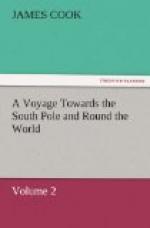At eight in the morning of the 19th, we saw the appearance of land in the direction of E. by S., or that of our course; but it proved a mere fog-bank, and soon after dispersed. We continued to steer E. by S. and S.E., till seven o’clock in the evening, when being in the latitude of 54 deg. 42’ S., longitude 13 deg. 3’ E., and the wind having veered to N.E., we tacked and stood to N.W. under close-reefed topsails and courses; having a very strong gale attended with snow-showers.
At four o’clock next morning, being in the latitude of 54 deg. 30’ S., longitude 12 deg. 33’. east, we tacked and stretched to N.E. with a fresh gale at S.W., attended with snow-showers and sleet. At noon, being in the latitude of 54 deg. 8’ S., longitude 12 deg. 59’ E., with a fresh gale at W. by N., and tolerably clear weather, we steered east till ten o’clock in the evening, when we brought-to, lest we might pass any land in the night, of which we however had not the least signs.
At day-break, having made sail, we bore away E., and at noon observed in latitude 54 deg. 16’ S., longitude 16 deg. 13’ east, which is 5 deg. to the east of the longitude in which Cape Circumcision is said to lie; so that we began to think there was no such land in existence. I however continued to steer east, inclining a little to the south, till four o’clock in the afternoon of the next day, when we were in latitude 54 deg. 24’ S., longitude 19 deg. 18’ east.
We had now run down thirteen degrees of longitude in the very latitude assigned for Bouvet’s Land. I was therefore well assured that what he had seen could be nothing but an island of ice; for, if it had been land, it is hardly possible we could have missed it, though it were ever so small. Besides, from the time of leaving the southern lands, we had not met with the least signs of any other. But even suppose we had, it would have been no proof of the existence of Cape Circumcision; for I am well assured that neither seals nor penguins, nor any of the oceanic birds, are indubitable signs of the vicinity of land. I will allow that they are found on the coasts of all these southern lands; but are they not also to be found in all parts of the southern ocean? There are, however, some oceanic or aquatic birds which point out the vicinity of land; especially shags, which seldom go out of sight of it; and gannets, boobies, and men-of-war birds, I believe, seldom go very far out to sea.
As we were now no more than two degrees of longitude front our route to the south, when we left the Cape of Good Hope, it was to no purpose to proceed any farther to the east under this parallel, knowing that no land could be there. But an opportunity now offering of clearing up some doubts of our having seen land farther to the south, I steered S.E. to get into the situation in which it was supposed to lie.
We continued this course till four o’clock the next morning, and then S.E. by E. and E.S.E., till eight in the evening, at which time we were in the latitude of 55 deg. 25’ S., longitude 23 deg. 22’ east, both deduced from observations made the same day; for, in the morning, the sky was clear at intervals, and afforded an opportunity to observe several distances of the sun and moon, which we had not been able to do for some time past, having had a constant succession of bad weather.




